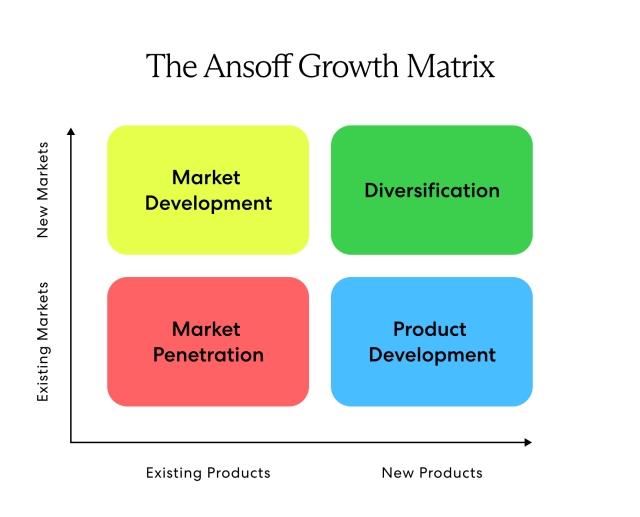Growing a business is an exciting prospect for many entrepreneurs, yet doing so requires enough research and preparation to execute the growth without letting it get out of hand.
Business growth strategies can help entrepreneurs identify actionable, direct ways to do so. They pinpoint your overarching goals with which you’ll build your course of action and provide insight into how you’re looking to approach your new product or market. This can be especially helpful for global growth, which requires careful planning to execute.
Entrepreneurs looking to go global may use a growth strategy defined by the Ansoff Growth Matrix.
What is the Ansoff Growth Matrix?
The Ansoff Matrix is a business growth strategy model that can guide entrepreneurs to the type of growth they’re looking for. The matrix defines business growth by various pairings of new products vs. new markets, encapsulating the many different ways entrepreneurs can build.
Nailing down which type of growth you’re aiming for can help you decide how to evolve your business as you go global. The types of growth strategies defined by the Ansoff Matrix are the following:

Market penetration
To put it simply, market penetration is entering an existing market with a similar product to those already being offered. The goal with a market penetration strategy is to enter an already thriving market and siphon some of the customer base away from those already competing in the space.
Step to success: Adjust pricing to compete with a major player in your market. Additionally, focus on enhancing customer experience and loyalty programs to retain your existing customer base.
Market development
Market development (also known as market expansion) involves taking your existing product and expanding it into new markets to attract a new customer base. In contrast to market penetration, market development involves a little more creativity because it forces the business owner to think of alternate ways their product could be used and additional demographics who could benefit from it.
Step to success: Conduct thorough market research to determine whether your new target will be a good fit. Leverage digital marketing and social media platforms to reach and engage new audience segments.
Diversification
A diversification strategy could appeal to business leaders who don’t mind a little risk. This strategy involves developing new product lines for new markets, diversifying your portfolio while trying to bring in new customers. Companies usually diversify to make more money in markets that they previously weren’t hitting.
Step to success: Pay attention to which markets are experiencing rapid growth to identify ways to enter them. Consider strategic partnerships or acquisitions to accelerate your entry into new markets and mitigate risks.
Product development
In a product development strategy, a business stays within their current market but creates a new product or modifies an existing one to attract new customers and increase their share of the market. While this cuts out the risk of entering a new market altogether, product development is still a riskier growth strategy that will involve careful planning because it involves the creation of something new.
Step to success: Be strategic with your marketing to emphasize your new product or service without putting your current offering on the back burner.
Strategic partnerships and acquisitions
Strategic partnerships and acquisitions are powerful drivers of business growth. By teaming up with like-minded companies, you can tap into complementary strengths and resources, speeding up market expansion, enhancing your product offerings, and accessing new technologies and expertise without starting from scratch.
More companies are pursuing these efforts internationally. Take Singapore, for example—it's one of the top Asian markets for global expansion, known for its finance sector. A Silicon Valley fintech startup specializing in blockchain technology could form a partnership with a Singaporean financial services company. These companies could develop an innovative cryptocurrency payment solution that leverages Singapore's status as a global financial hub with the fintech company’s blockchain expertise.
Similarly, strategic acquisitions can accelerate expansion by fast-tracking your access to new markets, technologies, or talent pools. When you buy another company, you're not just expanding your own business—you're absorbing their customer base, intellectual property, and market share in one fell swoop. This can be a transformative investment, especially if you're looking to quickly break into a new industry or global market.
How to develop a business growth strategy: 8 steps

Wanting to take your business global is an admirable goal, but it requires dedication to make sure your company succeeds. Let’s take a look at some ways you can develop a successful business growth strategy and set attainable growth goals.
1. Identify your ideal customer
Identifying your ideal customer is the first step to determining which markets or countries you should target with your expansion. Some companies suffer from an unclear idea of their ideal customer and spend marketing and advertising dollars on a market that won’t be lucrative. Honing in on a specific demographic can help avoid this issue.
Tip: Asking yourself why a person would buy your products or services can help you determine who that person is.
2. Pick your locale
Global expansion is a big move—literally. But picking where to expand can make or break the process. Think about which expansion location is going to be best for your business strategy. Once you have a shortlist of potential locations, conduct market research to determine the size of your target market, the economic situation, and how your product fares in each country.
Tip: Once you’ve picked your locale, hire local talent to immerse yourself into the culture and make yourself a welcome partner.
3. Conduct market research
Market research is always essential especially when expanding into a new market or country. Though you might be familiar with the market in your own country, foreign countries might provide additional challenges or tasks to do. As you start to expand, conduct research to glean insight into the customer base, competitors, and investor opportunities you’ll encounter in your new market.
Tip: By the time you finish your market research, you should have a healthy list of competitors, including their main selling point, pricing information, and unique offerings.
4. Set SMART goals
Goals are good for any leader. Specific, measurable, attainable, relevant, and time-based (SMART) goals will provide healthy benchmarks for your expansion that can keep you from getting off track. During a global expansion, SMART goals will measure things like revenue growth or employees hired.
Tip: Set both short- and long-term goals to help increase your confidence and keep you ever-focused on expanding.
5. Prepare financially
Moving to a new location comes with many costs, from rent in your new country and onboarding new hires to advertising expenses and the cost of kicking off your new business arm. Moving too quickly could cause trouble if you start writing checks you can’t cash, so run a thorough financial report to determine whether or not expansion is fiscally responsible.
Tip: Consider any mandatory payments that must be made to employees—for example, employers must contribute to employee pensions in the U.K.
6. Plan your course of action
A direct, actionable plan will help you stay on track. Turn your high-level goals into direct action by establishing what needs to be done to help you achieve what you’re aiming for. This could mean developing a marketing plan to reach your new market, hiring five new employees in the first quarter you’ve expanded, or conducting an audit to determine where you could better spend marketing dollars.
Tip: Align your SMART goals with your course of action to make an efficient, streamlined plan.
7. Consult a legal team
Different countries have different requirements for employee onboarding and workers’ rights, taxes, data security, and general business practices. Luckily, you can outsource legal help. An expert legal team can help you navigate these requirements so you stay compliant with local laws and regulations.
Tip: Velocity Global can help your business stay aligned with ever-changing labor laws.
8. Measure your success
Keep yourself accountable by regularly checking in with your SMART goals and seeing how your growth compares. With so much happening, it can be easy to let your actual goals fall by the wayside as new tasks and needs arise. Staying on track will become ever-important to ensure a successful transition and growth period.
Tip: Track your progress by measuring your day-to-day according to the goals you’ve set for your expansion.
Where to expand globally
Choosing where to expand is crucial to the success of any global business endeavor. The Milken Institute's Global Opportunity Index (GOI) 2024 provides valuable insights into the most attractive countries for foreign investment. This index evaluates countries based on 100 indicators across five categories: Business perception, economic fundamentals, financial services, institutional framework, and international standards and policy.
- Denmark: Leading the 2024 rankings, Denmark offers a highly attractive environment for international expansion. Its top position suggests a strong combination of economic stability, business-friendly policies, and robust institutions.
- Sweden and Finland: Following closely behind Denmark, these Nordic countries rank second and third respectively, indicating that the region as a whole presents significant opportunities for global businesses.
- United States: Ranking fourth overall, the U.S. stands out for its top position in Institutional Frameworks. However, it faces challenges in Economic Fundamentals due to high central government debt and inflation.
- Emerging markets: While advanced economies dominate the top rankings, the report highlights opportunities in emerging markets:
- Latin America: Mexico and Brazil are attracting significant foreign direct investment, jointly accounting for over 60% of FDI in the region. Mexico's appeal stems from its geographical location, positive business perception, and high economic openness, while Brazil benefits from advancements in financial services.
- Asia: Emerging and developing Asian economies perform relatively well in Financial Services, offering opportunities for businesses in this sector.
When considering global expansion, it's important to evaluate factors such as economic stability, business environment, market potential, and alignment with your company's goals and industry. The GOI serves as an objective benchmark, offering vital information to investors and policymakers looking to navigate the changing global economic landscape.
How to introduce your team to new cultures
Successfully introducing your team to a new culture or global location starts with education. Educate your team about the culture in the market you’re expanding into, including any cultural holidays, practices, customs, or etiquette that may be unfamiliar to your current locale.
A few more steps to take to get everyone on board with the growth:
- Emphasize the benefits: Tell your team about how globalization improves your company. Call out specific ways a new team or global location affects revenue, opportunities, and more.
- Be inclusive: If your teams speak different languages, provide translation solutions and ensure all company materials are available in these various languages.
- Build trust: It can be easy for global teams to feel disconnected from one another. Find time for international team members to interact by having informal discussions in meetings or hosting a few networking events on a digital platform.
- Communicate frequently: Togetherness and communication are vital to an international team's function. Send frequent memos and host check-ins with team members worldwide to ensure everyone is on the same page and working toward common goals.
Ready to go global?
Expand your business abroad with Velocity Global. Our Employer of Record (EOR) solution makes it easy to enter new markets and onboard global talent with unmatched scale, in-country expertise, and a robust global workforce management platform.
Contact us today to start your global growth journey.
Topic:
Global Growth



